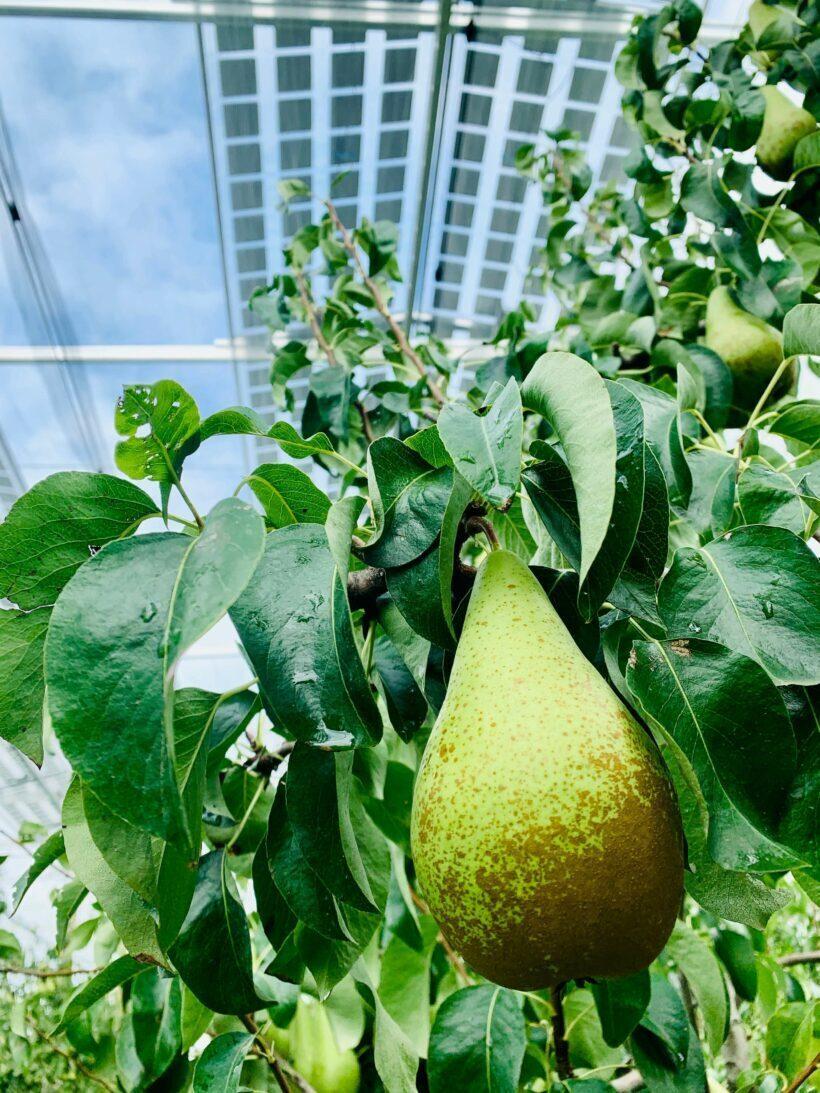New agrivoltaics pilot projects generate solar energy between fruit trees
Harvesting fruit and electricity at the same time at a fruit orchard ? Agrivoltaics, a combination of growing crops and producing solar energy with solar panels, makes it possible and presents an important added value for the energy transition. Hence it’s no wonder various pilot projects are seeing the light of day all over Flanders. EnergyVille/KU Leuven is also involved investigating the configurationof the solar panels with an innovative calculation tool. Here follows a small overview.
Agrivoltaics: what, why and how?
Farms with solar panels on top of their roofs are quite well known. And also solar parks, large open grounds with solar panels, color many landscape views. But what if the two would be combined? Instead of using our scarce, fertile farmland for solar parks, we can also integrate the production of food (agriculture) and energy (with photovoltaics) through agrivoltaics. Because after all, half of the surface of Belgium consists of agricultural land, generating a wide range of possibilities.

But what exactly does an agrivoltaics installation look like? With agrivoltaics, solar panels are placed above or in between the fields or fruit trees. These can be standard solar panels, but also double-sided, so-called bifacial solar cells. In a pilot project in Bierbeek for example, bifacial panels were placed above the pear trees. “There were already hail nets in the pear orchard of the fruit company Van der Velpen. We used the constructions for the nets to install the solar panels. These are semi-transparent solar panels. The solar cells in the panels are spaced further apart, so light can get through, which is essential for the pears to grow. These are also bifacial solar panels: double sided panels that absorb light on both sides, both the direct sunlight and the reflection of that light from the ground,” says Professor Bram Van de Poel of the Department of Biosystems at KU Leuven.
A pilot project was also started in Someren in the Netherlands with the cultivation of strawberries and raspberries. Here, the ‘fruit roofs’ with solar panels are an alternative to the traditionally used white foils. The irrigation of the crops is controlled fully automatically in the construction.
On another test field in Grembergen, this time cultivating beetroot, traditional solar panels are lined up vertically between rows of beets. These intercept more light, but they are cheaper than semi-transparent solar panels. And they can rotate: you can turn them so that they provide more shade during a heatwave, for example.
At the KU Leuven test farm TRANSfarm in Lovenjoel, standard solar panels will be placed horizontally over the crops, but they will be mobile. Hence, we will be able to increase or decrease the distance between the panels, and test the resulting effects.
To measure is to know
Different test setups require a thought out approach. Accurate calculations are required to know what the most efficient configuration is. Not only do you have to find the right balance between a profitable harvest and generated power, the incidence of light, humidity and temperature also need to be continuously monitored.
Enter EnergyVille/KU Leuven. Professor Jan Cappelle and his team from the technology campus in Ghent developed a tool precisely to perform these calculations. “You have to take a variety of factors into account. What is the orientation of the field? What crops grow on it? Pear trees grow for many years and cannot be moved. On some fields, there is crop rotation: beets one year, potatoes or corn the next. What is the orientation of the rows of crops? All these factors make a difference for solar panels: how should they be positioned? How many should there be and of what type? With our tool, developed within KU Leuven and EnergyVille, we first make a 3D simulation of the optimal yield under the panels, before we start building,” explains Professor Capelle.

Waiting for the first harvest
The production and condition of the fruit or the crops under the solar panels is monitored very closely using sensors. “In the pear orchard, for example, we monitor whether the blossoms are delayed, the size of the first leaves, and we compare them to a standard orchard. And we are of course waiting for the first harvest: we want to know the yield and quality of the pears under the solar panels. The harvest will only be in late September or early October, but everything looks very good so far.”
The production of electricity with agrivoltaics is a different story. The generated energy is currently only economically worthwhile for personal use. “But farmers could supply electricity to families or companies in the area. Unfortunately, Belgian legislation does not yet permit this. If that obstacle were to be removed, agrivoltaics might really take off. There is great interest among farmers.”
The electricity yield is also continuously monitored and used as efficiently as possible. At the moment, the electricity generated is mainly interesting for self-consumption: “In the future, farmers should be able to supply electricity to families or businesses in the neighborhood. Unfortunately, Belgian legislation does not yet permit this. If that obstacle were to be removed, agrivoltaics might really take off. There is great interest among farmers..”
If the pilot projects prove to be successful, there is great potential for agrivoltaics. For now, we still have to wait for the official figures of its potential until after the harvest. The final results of the first pilot projects are expected in the autumn. More information will of course follow in due time.
